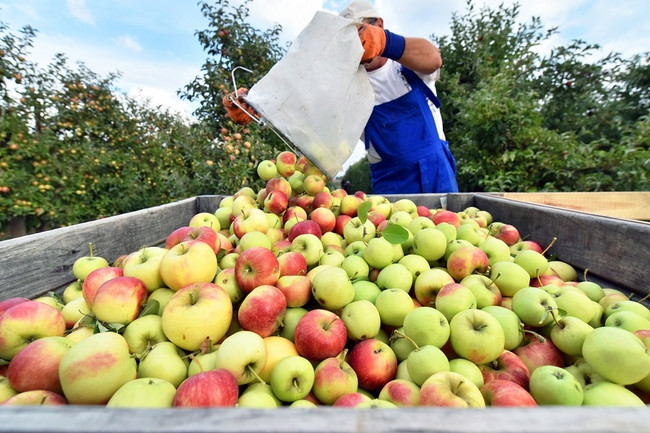✕



✕

Tag:us apple farm crop health healthclimate conditions and apple marketability 2025-01-10 10:04

Leading apple-producing regions in the US, including states like Washington, which account for more than 60% of the country’s apple production, are facing major challenges brought on by climate change.
A Washington State University (WSU) research has analyzed over 40 years of climate conditions that affect the growth of apple trees, from bud break and flowering to stages when fruits develop, mature and show color.
The study reveals that while several areas are prone to increased climate risks, the top three largest-producing counties are most impacted. These include Yakima in Washington, Kent in Michigan and Wayne in New York.
“We shouldn’t take the delicious apples we love to consume for granted,” says Deepti Singh, a WSU climate scientist and the study’s corresponding author.
“Changing climate conditions over multiple parts of the growth cycle pose potentially compounding threats to the production and quality of apples. Moving forward, it would be helpful to think about adaptations at different stages of apple growth that can minimize overall harmful impacts.”
The team aims to study the projections and share insights with the tree fruit industry, which, according to the USDA, generates around US$28 billion in farm cash receipts annually.
Metrics to monitor crop health
The study, published in the journal Environmental Research Letters, analyzes data from 1979 - 2022. The metrics include chill portions, cold degree days, frost risk, growing degree days, extreme heat days and warm nights.
Extreme heat days are those with a maximum temperature greater than 34 degrees Celsius, which can result in sunburns. Warm nights are when temperatures are more than 15 degrees Celsius, which can severely impact coloration.
The researchers also studied the number of cold days or the number of colder hours an apple tree needs to be as well as growing degree days, which are the days conducive to apple growth.
Variations in these metrics can hamper apple production, affecting the time when flowers bloom and increasing the risk of apples getting sunburned. This affects the appearance and quality of the fruit.
Climate conditions and apple marketability

Among the top apple-producing regions, Yakima County has more than 48,800 acres of apple orchards and has seen detrimental tendencies in five of the six metrics the researchers analyzed.
The study notes that the western part of the US has experienced the strongest trends in various metrics that deteriorate crops.
The paper notes that the crop requires favorable climate conditions over its life cycle for good yields and properties that can increase marketability, such as color, size and flavor.
The problem gets more complex as apple trees are perennials, explains co-author Lee Kalcsits, a WSU tree physiologist who leads programming at the Wenatchee Tree Fruit Research and Extension Center.
“What goes on in different seasons can affect long-term health as well as the performance and productivity of the apple tree during that specific season,” he says.
“So what goes on in the winter affects what happens in the spring, which affects the summer, and it just keeps going around in a cycle.”
With the US being the third largest producer and exporter of apples in the world, the industry generates approximately US$3.1 billion in farm revenue, according to the USDA. Worsening climate conditions are only expected to continue posting threats to apple production.
Helping growers adapt
Kalcsits reveals that growers are already adapting in places like Washington, where they are using netting and evaporative cooling techniques to mitigate sunburn during extreme weather events that cause frequent heat.
Kirti Rajagopalan, a WSU biological systems engineer and study co-author, says that Washington is “a great place to start to talk about adaptation.”
“A lot of the commercial apple production happens in the northern US. There are also parts of Washington where the summers can get pretty hot, so this is a good place for a case study — and if we can manage it here, then it’s likely manageable elsewhere, too.”
Researchers are already helping the industry adapt. Kalcsits is heading a government-funded project to address the impact of extreme climate events on pear and apple crops.
“Silent emergency”: Lower-income adults over 50 face nutrition and mental health risks
Scientists develop advanced genetic maps to boost resilience and yields of vital food crops
The Korean Twist That Takes Grilled Cheese To New Heights
What It Means When Your Frozen Steak Turns Green
Why Stacking Plates At A Restaurant Might Not Be As Helpful As You Think
About Us Terms of Service Privacy Policy Contact Us
Hotline(+86)17301604571
 Enterprise WeChat
Enterprise WeChat
for Client Service
 EZBuy
EZBuy
WeChat APP
Sinoexpo Digital Platform
Shanghai Sinoexpo Informa Markets International Exhibition Co., Ltd. All rights reserved
沪ICP备05034851号-77
 沪公网安备31010402000543号
沪公网安备31010402000543号